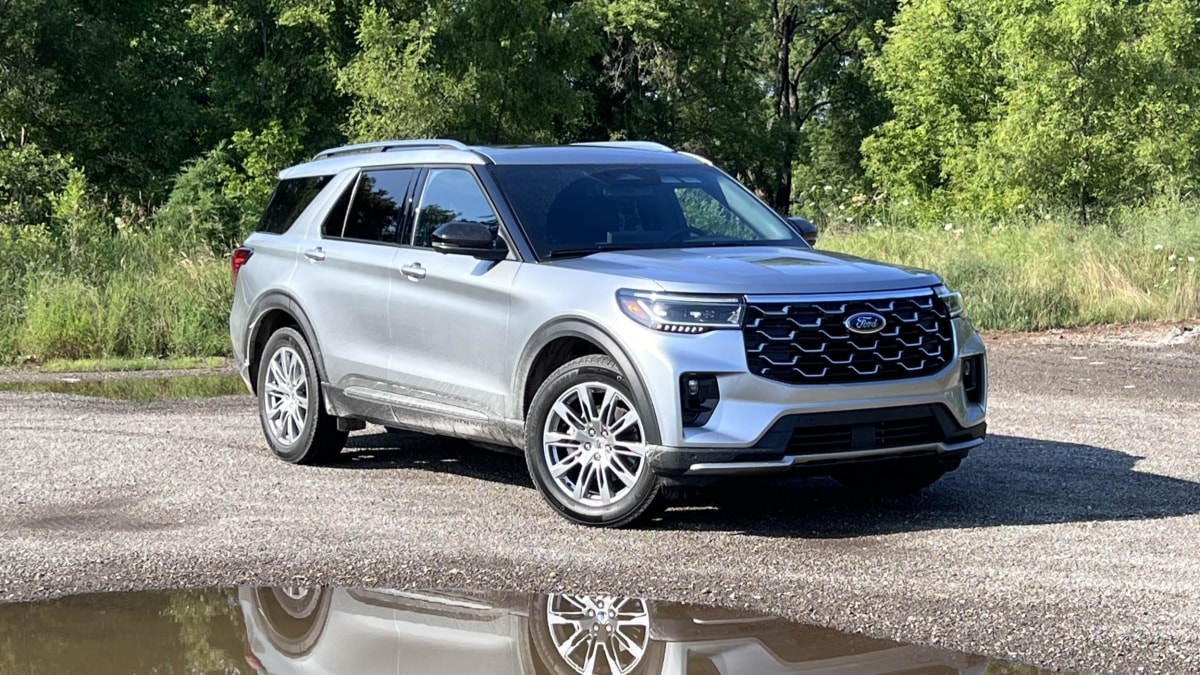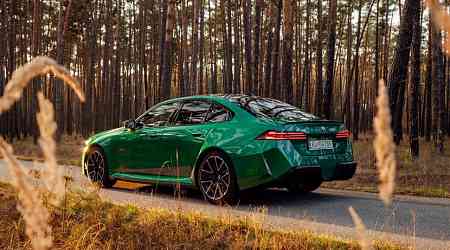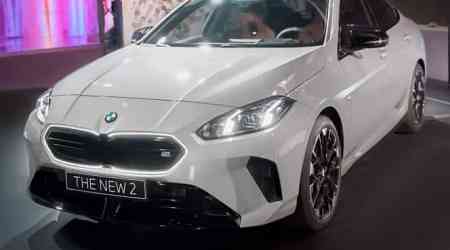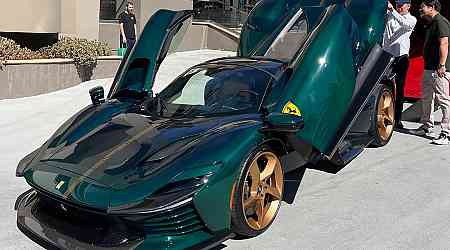CHELSEA, Mich. — By looking at the 2025 Ford Explorer from the outside, you wouldn’t think Ford did much to update it. The 2025 model looks a lot like the handsome Explorer we’re already well familiar with, but with some styling tweaks that are neither a major overhaul nor exactly subtle. Up front, the big change is the new, larger grille — a trend common to the segment of late, but not a bad one. Each trim gets its own version of the grille to help set them apart. The Explorer also gets redesigned LED headlights and larger air curtains positioned lower on the fascia to give the SUV a planted-looking stance. In back, the liftgate is redesigned with LED taillights that cross the gap from the corners to blend into the nameplate stretching across the middle. It all looks good — just a freshening and tidying up of an already handsome design that is unmistakably Ford.
There’s been a much bigger overhaul to the Explorer’s interior for 2025, fixing our biggest gripes about a chintzy, unattractive cabin and making it considerably more competitive in the segment. The cockpit is inviting, which couldn’t exactly be said about most trims in the past. Gone are the seas of grainy black plastic, replaced with interesting design everywhere you look and soft-touch materials pretty much anywhere you rest your hands. It’s more lounge-like than before, with a bit of a home theater vibe to it. The speakers are hidden behind fabric across the dash in the style of a sound bar on either side of the two digital screens — one for infotainment and one serving as an instrument panel. Below the central screen (and a volume knob alongside a row of buttons), is a nice little shelf with room for storing two phones. That’s also where the wireless charger lives, if so equipped.
Ford dubs the new infotainment system the “Ford Digital Experience.” In the ’25 Explorer, the 13.2-inch touchscreen does the usual car stuff, but incorporates more of the features and apps many use on their phone, or even TV, every day. It includes wireless Apple CarPlay and Android Auto, as well as Amazon Alexa and Google Built-In (with Google Assistant). The Google Play app offers various music streaming services, and even video streaming platforms like YouTube, Peacock and Prime Video, allowing you to make the most of your downtime. We were even able to play the racing video game “Asphalt Nitro 2” using a Bluetooth-connected game controller. Lounge-like, indeed. If you need more work in your work-life balance, you can even use the Webex app for conference calls — video is enabled while stationary, and it goes audio-only if you take a meeting while driving. It might be just a tad too digital in some respects, with things like HVAC controlled through the touchscreen rather than with physical buttons, though the controls remain docked at the bottom of the screen most of the time (though they were hidden while we played “Asphalt”).
The Explorer has three rows, with standard seating for seven (many competitors can manage eight), though you can opt to swap the second-row bench for captain’s chairs and therefore a six-person capacity. Passenger space remains the same, apart from a smidge extra shoulder room up front due to the redesign. If you do choose the captain’s chairs, your third-row passengers will be able to stretch a leg into the pass-through, making it more comfortable for longer-legged individuals, especially if second-row riders are willing to slide their seats forward a bit (and there’s a fair amount of room to do that). Headroom is good regardless of the row you’re sitting in, which will definitely be appreciated if you’re packing the seats full of adults.



Switching to the front of the Explorer, the base engine is a good one: The turbocharged 2.3-liter four-cylinder EcoBoost looks the same on paper, but is internally more similar to that in the new Mustang. As before, it makes 300 horsepower and 310 pound-feet of torque, and is mated to a 10-speed automatic transmission that’s been retuned for smoother driving. Rear-wheel drive is standard, but all-wheel drive is available, of course. Fuel economy only drops by one mile per gallon with AWD, at 23 mpg, compared to 24 with RWD. The 2.3 is the standard engine in the Active, ST-Line and Platinum trims. Standard in the ST, and optional in the Platinum trim, is the also-carry-over 3.0-liter EcoBoost V6 engine making 400 horsepower and 415 pound-feet of torque. Again, there’s a 10-speed autobox and rear-wheel drive, with available all-wheel drive, and Ford estimating 21 mpg combined for both.
Our first drive loop took place in an Explorer Platinum with the 2.3-liter engine and AWD. First impression: This thing sounds quite good, better than a turbo-four has business sounding. It is, in fact, reminiscent of the EcoBoost sound in the Mustang, and encouraged us to get on the accelerator hard whenever the opportunity arose. Overall, despite nothing changing in terms of output, there’s a bit more character from the base engine, something the Explorer definitely needed. It feels amply potent, and putting it into Sport mode makes it a bit more eager and alert, almost fun. Sport mode also tightens up the steering feel on center, too, making the inputs feel a little more accurate and direct as you roll it through curves.
But otherwise, the drive isn’t really different than before. It’s still acceptably quick, but not excitingly so. It’s comfortable to drive whether you’ve got smooth highway or rutty dirt roads — we had our share of both, and the Explorer felt like it minded its own business rather than chatter back at us through the chassis. In that same respect, it’s not a particularly engaging car to drive, and its mission isn’t exactly to communicate with you as you hunt for the next apex. It’s still an SUV, not a sport coupe, after all, and it’s good at its assignment of being a practical and attractive daily transport whether you’re going to soccer practice or on a camping trip in the woods.
Speaking of which, we did get a chance to sample the Explorer — specifically an ST-Line — on a mild off-road trail through the woods. The rain from earlier in the morning and previous night worked in our favor to give us some nice mud to slide through as we wound between trees. We don’t imagine many people will take their Explorer off-roading (though we do hope Ford brings back the Timberline), but this was a pretty accurate replication of what we could see ourselves getting into while recreating or just exploring the prettier parts of the state. It’s nice to know we probably wouldn’t get stuck.
Back on actual roads, we drove the Explorer Platinum with the 3.0-liter engine and rear-wheel drive. With 100 more horsepower than the 2.3, it’s a bit quicker, and was happy to get the tires singing when gunning through a corner. But, for the most part, we didn’t actually feel much of a difference between it and the 2.3, be it when driven normally or even somewhat enthusiastically. For one thing, the 3.0-liter is quieter, which probably diminished the perception of outright speed. Both engines are rated to tow 5,000 pounds, though we suspect that’s where’d we’d notice more of a separation between the powertrains (we did not get a chance to tow during the first drive event). If you’re choosing between the 2.3- and 3.0-liter engines in the Platinum trim (the only trim that offers both), or picking your trim based on the available engines, you’ll have to do the value calculus for yourself, knowing the difference in fuel economy among the powertrains is marginal. The 3.0 is a $4,615 option in the Platinum. For that money, we’d probably stick with the 2.3. It was plenty of engine for the Explorer, at least without a trailer in tow.
Ford’s BlueCruise hands-free highway driving assist system is equipped on the Explorer for 2025, in the ST-Line trim and up. This is the new BlueCruise 1.2, which adds a couple more capabilities to the previous version. It can now perform automatic lane changes — just tap the turn signal, and the car will switch lanes in the indicated direction if it can do so safely. It will also move over in your lane a bit to give a little more space between you and that truck that seems to be driving just a little too close. It works well, providing largely stress-free highway driving, though it’s not quite as robust as GM’s exemplary Super Cruise, and we had more frequent disengagements as well. Opting for it is unusual, however, as it is technically a subscription service. You can pay for the first year upfront for a discounted price of $700. Otherwise, it comes with a 90-day free-trial, and costs $800 a year after that, or $75 a month if you just want to pay for the months that you’ll actually use it. This may work for many, as you can simply opt back into service when you know you have a big road trip coming up.

And, no, we didn’t forget about the ST. Our highway drive in the 3.0 took us to a facility where Ford set up an autocross course on which to sample the sporty model. It comes standard with the 400-horsepower 3.0-liter V6, as well as a sport-tuned suspension, better brakes, unique styling, captain’s chairs and many of the luxury items in the Platinum. Our drive was brief — just a couple of laps — but we were better able to notice the power of the 3.0-liter when stringing together tight corners, as well as the confidence inspired by the suspension, and the overall more communicative chassis. It’s always a hoot to get the tires a-hollerin’ on a family vehicle.
The Explorer lineup starts with the base Active trim ($41,350 with RWD; $43,350 with AWD), followed by the ST-Line ($46,110; $49,105) and ST ($57,100; $60,795). The Platinum with the 2.3-liter starts at $53,250 with RWD and $55,250 with AWD, or $57,865 for the 3.0 RWD, and $59,865 with the V6 and AWD. All the above prices include the $1,595 destination charge.
Yeah, that’s a bit more expensive than some of the competition, but the 2025 Explorer does more than before to justify the price. The much-improved interior is a huge part of that, as is the tech experience. The inclusion of BlueCruise equipment is also a plus, if you’re willing to pay the subscription fees (the mere existence of which may just be an aggravation to some, admittedly). But if you want a good-looking, known-quantity SUV that now has a far more competitive interior, Ford’s got it for you in the new Explorer.
































